ATI's Late Response to G70 - Radeon X1800, X1600 and X1300
by Derek Wilson on October 5, 2005 11:05 AM EST- Posted in
- GPUs
Budget Performance
For budget performance, we feel that 1024x768 is the proper target resolution. People spending near the $100 mark can't expect to acheive performance at high resolutions. But with current hardware, we can play games at moderate resolutions without loosing any features.
The X1300 is targeted at the budget market, but we focued on testing our X1300 Pro against slightly higher performing parts because of it's pricing. The X1300 does quite well versus the traditional low end 6200 TC and X300 parts, but can't really compete with the 6600 GT which is priced near the $149 MSRP of the X1300 Pro.
Under Doom 3 (and many OpenGL applications) NVIDIA holds a lead over ATI hardware. While it is understandable that the X1300 Pro isn't able to match preformance with NVIDIA's $150 6600 GT, the $250 MSRP X1600 XT laggs far behind as well. It is quite interesting to note that the X1600 closes that gap (and performs slightly better than the 6600 GT) when 4xAA and 8xAF are enabled at this resolution. But at such low res, the better bet is to increase the setting to 1280x1024 with no AA where the 6600 GT maintains about a 20% performance lead. Doom 3 is also a fairly low contrast game, meaning that jagged edges are already hard to see.
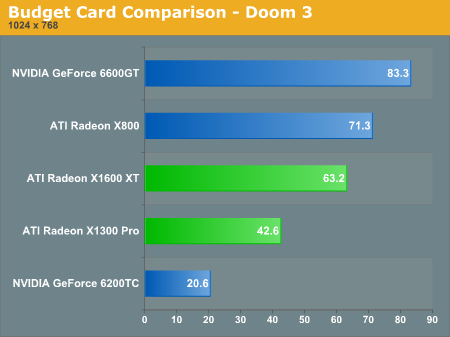
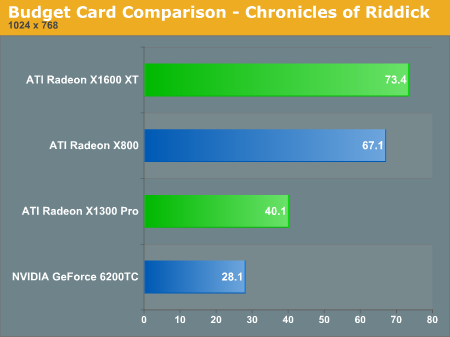
Under Valve's Day of Defeat: Source, the latest resurrection of a past title by Valve (and also the first to feature HDR), The 6600 GT and X800 perform on par with what we would expect while the more expensive X1600 XT lags behind and the X1300 looks to perform where a budget card should. Enabling 4xAA and 8xAF on this game closes the gap between the 6600 GT and X1600 XT: they both run at about 48 fps under this setting, followed by the X800 at nearly a 43 fps average.
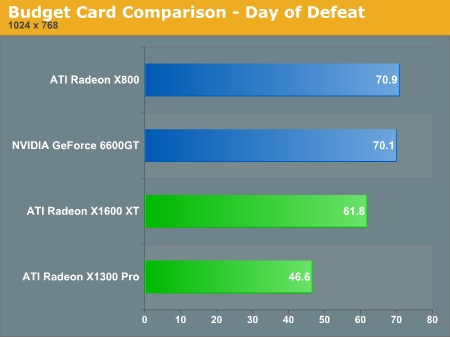
Far Cry provides a victory for the X1600 XT over the 6600 GT, but we still have the expensive X1300 Pro lagging it's closer cost competitor by a large margin.
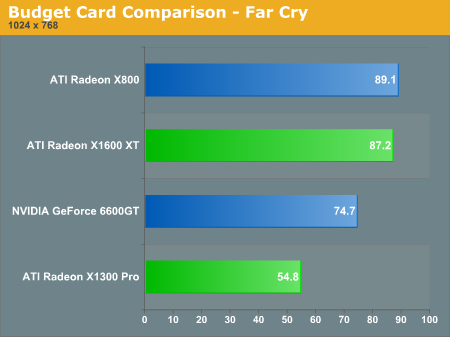
Everquest II on very high quality mode shows the X1600 XT to lead this segment in performance. Current ~$100 parts are shown to perform horribly at this setting scoring single digit framerates. The X1300 Pro is definitely playable at very high quality at 1024x768 (which we would recommend over a lower quality setting at a higher resolution). Extreme quality still doesn't perform very well on any but the most expensive cards out there and really doesn't offer that much more interms of visual quality.
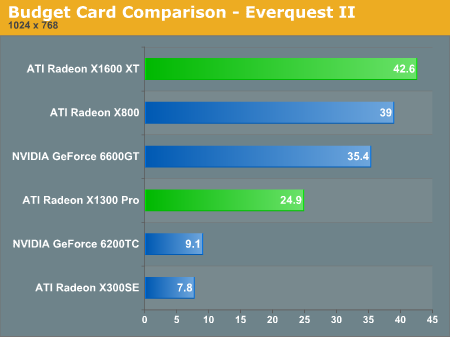
When testing Splinter Cell: Chaos Theory, the new X1000 series of cards give a very good performance. This time around, the X800 and 6600 GT don't perform equally, and it looks as though the additions to the RV5xx architecture can make quite a difference depending on the game being played.
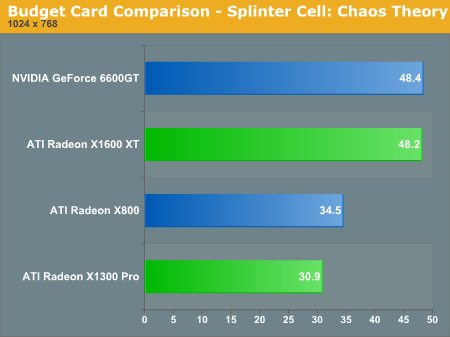
To see the continuing saga of the X1600 XT, we will take a look at midrange performace numbers at 1280x960.
For budget performance, we feel that 1024x768 is the proper target resolution. People spending near the $100 mark can't expect to acheive performance at high resolutions. But with current hardware, we can play games at moderate resolutions without loosing any features.
The X1300 is targeted at the budget market, but we focued on testing our X1300 Pro against slightly higher performing parts because of it's pricing. The X1300 does quite well versus the traditional low end 6200 TC and X300 parts, but can't really compete with the 6600 GT which is priced near the $149 MSRP of the X1300 Pro.
Under Doom 3 (and many OpenGL applications) NVIDIA holds a lead over ATI hardware. While it is understandable that the X1300 Pro isn't able to match preformance with NVIDIA's $150 6600 GT, the $250 MSRP X1600 XT laggs far behind as well. It is quite interesting to note that the X1600 closes that gap (and performs slightly better than the 6600 GT) when 4xAA and 8xAF are enabled at this resolution. But at such low res, the better bet is to increase the setting to 1280x1024 with no AA where the 6600 GT maintains about a 20% performance lead. Doom 3 is also a fairly low contrast game, meaning that jagged edges are already hard to see.


Under Valve's Day of Defeat: Source, the latest resurrection of a past title by Valve (and also the first to feature HDR), The 6600 GT and X800 perform on par with what we would expect while the more expensive X1600 XT lags behind and the X1300 looks to perform where a budget card should. Enabling 4xAA and 8xAF on this game closes the gap between the 6600 GT and X1600 XT: they both run at about 48 fps under this setting, followed by the X800 at nearly a 43 fps average.

Far Cry provides a victory for the X1600 XT over the 6600 GT, but we still have the expensive X1300 Pro lagging it's closer cost competitor by a large margin.

Everquest II on very high quality mode shows the X1600 XT to lead this segment in performance. Current ~$100 parts are shown to perform horribly at this setting scoring single digit framerates. The X1300 Pro is definitely playable at very high quality at 1024x768 (which we would recommend over a lower quality setting at a higher resolution). Extreme quality still doesn't perform very well on any but the most expensive cards out there and really doesn't offer that much more interms of visual quality.

When testing Splinter Cell: Chaos Theory, the new X1000 series of cards give a very good performance. This time around, the X800 and 6600 GT don't perform equally, and it looks as though the additions to the RV5xx architecture can make quite a difference depending on the game being played.

To see the continuing saga of the X1600 XT, we will take a look at midrange performace numbers at 1280x960.










103 Comments
View All Comments
HamburgerBoy - Wednesday, October 5, 2005 - link
Seems kind of odd that you'd include nVidia's best but not ATi's.cryptonomicon - Wednesday, October 5, 2005 - link
I was expecting ATI to make a comback here, but the performance is absolutely abysmal in most games. I dont know what else to say except this product is just gonna be sitting in shelves unless the price is cut severely.bob661 - Thursday, October 6, 2005 - link
LOL! I wouldn't say abysmal. Abysmal would be the X1800XT performing like a 6600GT. The card that doesn't do well is the X1600. X1800's are fantastic performers and certainly much better than my 6600GT at displaying all of a games glory. It just wasn't the ass kicker most everyone hyped it up to be. But technically speaking, it IS an ass kicker.flexy - Wednesday, October 5, 2005 - link
i am a bit disappointed - while at work i overflew the other reviews and then, as the crowning end of my day i read the AT review.I (and probably many others) were waiting for this card like it's the best think since sliced bread - and now, WAY too late we do *indeed* have a good card - but a card which is a contender to NV's offerings and nothing groundbreaking.
Don't get me wrong - better AF/AA is something i always have a big eye on, but then ATI always had this slight edge when it came to AF/AA.
The pure performance in FPS itself is rather sobering - just what we're used to the last few years...usually we have TWO high-end cards out which are PRETT MUCH comparable - and no card is really the "sliced bread" thing which shadows all others.
This is kind of sad.
The price also plays a HUGE factor - and amongst the nice AA/AF features i have a hard time to legitimate say spending $500 for "this edge"...especially as someone who already owns a X850XT .
Not as long i am still playable in HL2/DOD/Lost Coats etc....i dont think i will see FPS fall *that quick* - in other words: I can "afford" to wait longer (R580 ?) and wait for appropriate Game engines (UT2K4 ??) which would make it necessary for me to ditch my X850XT because the X850 got "slow".
D3/OpenGL performance is still disappointing - but then i dont know what NV-specific code D3 uses - but still sad to see this card getting it in the face even if it now has SM3.0 and everything.
Availability:
Well..here we go again....
Bottomline: If i were rich and the card would be orderable RIGHT NOW i would get the XT - no question.
But since i am not rich and the card is *a bit* a disappointment and obviously NOT EVEN AVAILABLE - i will NOT get this card.
It's time to sit back, relax, enjoy my current hardware, watch the prices fall, watch the drivers get better...and then, maybe, one day get one of those or A R580 :)
I WISHED it would NOT have been a day making one "sit and relax" but instead burst out in joy and enthusiasm....but well, then this is real life :)
Wesleyrpg - Thursday, October 6, 2005 - link
summarised very well mate!Regs - Wednesday, October 5, 2005 - link
They were likely better off trying to market that we didn't need new video cards this year and save their capital for next year. These performance charts, especially the "mid range" parts are awfully embarrassing to their company.photoguy99 - Wednesday, October 5, 2005 - link
I assume it was not one of the cards that come overclocked stock to 490Mhz?It seems like it would be fair to use a 490Mhz NVidia part since manufacturers are selling them at that speed out of the box with full warrenty intact.
Evan Lieb - Wednesday, October 5, 2005 - link
"Unless you want image quality."There is no image quality difference, and I doubt you've used either card. Fact of the matter is that you'll never notice IQ differences in the vast majority of the games today. Hell, it's even hard to notice differences in slower paced games like Splinter Cell. The reality is that speed is and always will be the number one priority, because eye candy doesn't matter if you're bogged down by choppy frame rate.
Right now, there is zero reason to want to purchase these cards, if you can even find them. That's fact. Accept it and move on until something else is released.
Madellga - Thursday, October 6, 2005 - link
Quality includes also playing a game without shimmering. I can't get that on my 7800GTX.Before anyone replies, the 78.03 drivers improve a lot the problem but does not fix it.
The explanation is inside Derek's article:
"Starting with Area Anisotropic (or high quality AF as it is called in the driver), ATI has finally brought viewing angle independent anisotropic filtering to their hardware. NVIDIA introduced this feature back in the GeForce FX days, but everyone was so caught up in the FX series' abysmal performance that not many paid attention to the fact that the FX series had better quality anisotropic filtering than anything from ATI. Yes, the performance impact was larger, but NVIDIA hardware was differentiating the Euclidean distance calculation sqrt(x^2 + y^2 + z^2) in its anisotropic filtering algorithm. Current methods (NVIDIA stopped doing the quality way) simply differentiate an approximated distance in the form of (ax + by + cz). Math buffs will realize that the differential for this approximated distance simply involves constants while the partials for Euclidean distance are less trivial. Calculating a square root is a complex task, even in hardware, which explains the lower performance of the "quality AF" equation.
Angle dependant anisotropic methods produce fine results in games with flat floors and walls, as these textures are aligned on axes that are correctly filtered. Games that allow a broader freedom of motion (such as flying/space games or top down view games like the sims) don't benefit any more from anisotropic filtering than trilinear filtering. Rotating a surface with angle dependant anisotropic filtering applied can cause noticeable and distracting flicker or texture aliasing. Thus, angle independent techniques (such as ATI's area aniso) are welcome additions to the playing field. As NVIDIA previously employed a high quality anisotropic algorithm, we hope that the introduction of this anisotropic algorithm from ATI will prompt NVIDIA to include such a feature in future hardware as well. "
Phantronius - Wednesday, October 5, 2005 - link
Unless you a fanboy